Music and Movement: Enhancing Preschool Learning Through Songs
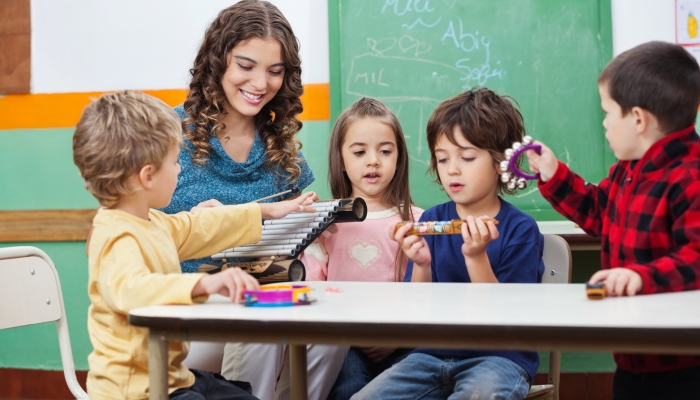
- Music and movement activities for preschool children help develop necessary cognitive skills, building the pathway to understanding, remembering, and imagining.
- Musical activities teach children language development, spatial intelligence, and social skills.
- Parents and teachers can encourage music and movement to enhance a child’s motor skills as they develop and grow.
A music class was one of my first mommy-and-me classes with my son; we had so much fun. I hadn’t realized how important music and movement was for my growing boy. Admittedly, he just banged the sticks together in the first class I took him to.
However, the more classes we attended, the more benefits I could see him reaping. Sitting and observing him watching the teacher and mimicking her motions through music was interesting.
Adding music and movement for preschool children at home or in the classroom while playing fun songs is a fantastic way to encourage their development.
The Science Behind Music and Learning
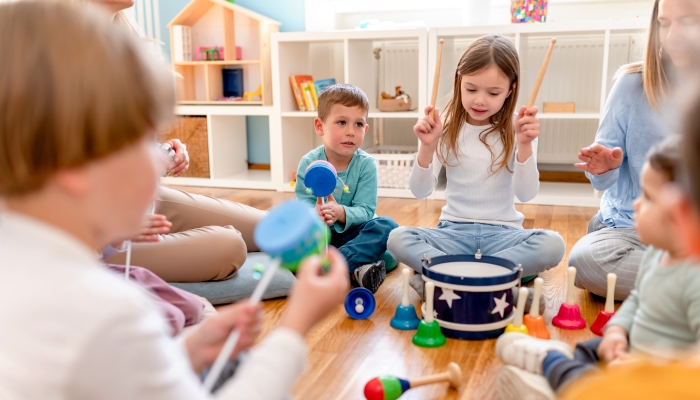
Incorporating music and movement into your preschool curriculum enriches the learning experience and provides a well-rounded approach to early childhood development.
Music instruction has been shown to accelerate brain development in young kids, especially in parts of the brain that processing sound and developing speech, language, and social skills, according to a five-year study11. Habibi, A., Cahn, B. R., Damasio, A., & Damasio, H.. Neural Correlates of Accelerated Auditory Processing in Children Engaged in Music Training. Developmental Cognitive Neuroscience. 2016;21, 1–14. https://doi.org/10.1016/j.dcn.2016.04.003 conducted by the Brain and Creativity Institute at the University of Southern California.
It’s important to understand that the specific type of music, the context in which it is presented, and distinct individual differences contribute to the music and cognitive processes.
Here’s a look at a few of the significant benefits of adding music to learning.
Cognitive Benefits
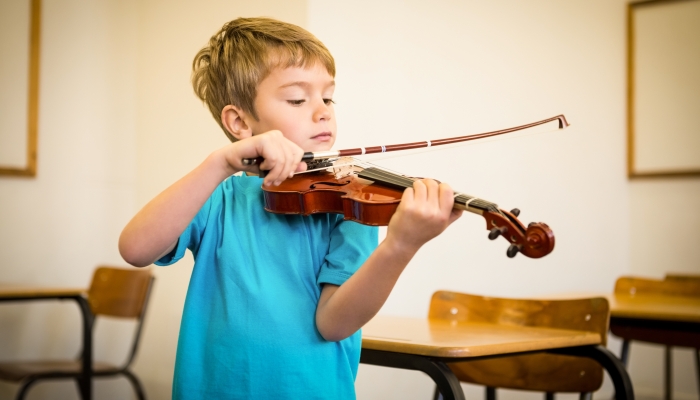
The cognitive development of preschoolers is an important aspect of knowledge growth, helping your child’s ability to think, communicate, remember, imagine, and understand.
You’ll notice many cognitive benefits when you incorporate music with learning. Music can help to:
- Strengthen memory.
- Enhance concentration.
- Encourage spatial awareness.
- Improve language proficiency.
- Develop listening skills.
Music and movement have a fantastic way of building the stepping stones for success in the cognitive development of a child.
Emotional Benefits
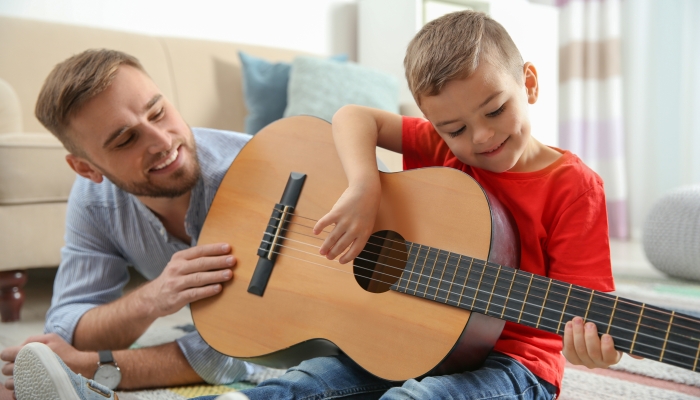
Emotional benefits of music for preschoolers include boosting self-esteem and encouraging emotional expression. In addition, learning music or how to play musical instruments takes great patience, which also helps develop self-regulation skills.
Listening to music is also a great way to create joy and positivity in preschoolers while uplifting moods and encouraging social-emotional development.
For many, music is an emotional outlet, offering a safe place to explore a range of emotions, from joy and excitement to calmness and sadness.
In addition, for children without fully developed verbal communication, music provides a way to express emotions in a non-verbal manner.
Physical Benefits
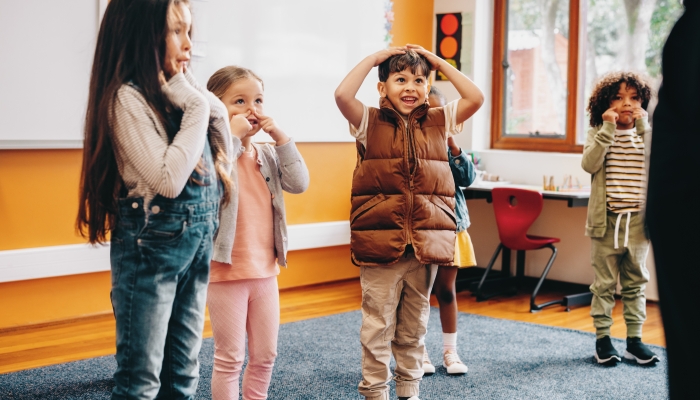
Music is a great physical activity for young kids to work on their fine and gross motor skills while playing along with music. Gross motor milestones for preschoolers help support the development of additional areas, including visual, oral, and fine motor skills.
One of my favorite music games is to play freeze dance, which gets preschoolers moving around and working their large muscles. Movement activities for preschoolers are like a dance party in the classroom!
You can also take the fun outside, allowing additional space for music and movement activities.
Creativity Benefits
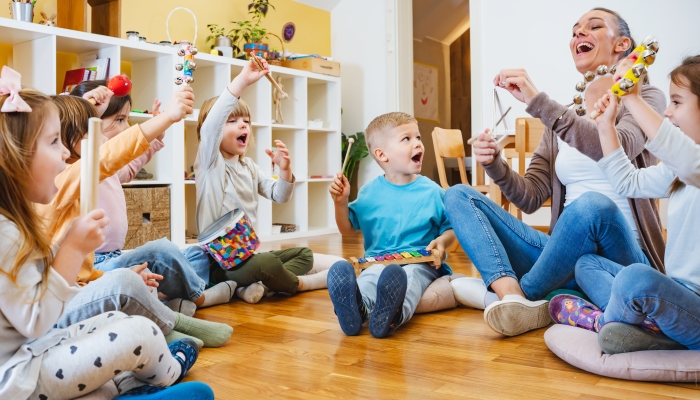
Music and movement have various benefits in developing the creativity and imagination of kids. Music helps encourage self-expression while stimulating creativity and story-telling skills.
Since music and movement naturally lead to improvisation, it allows children to develop their own movements and ideas, helping boost their creativity.
Choose songs with narratives and imaginative movement activities to further engage a child’s imagination. You can tell the children that when the music starts, they can dance however they feel it moves them.
It’s always fun to watch preschoolers interpret songs into movement when they can.
Bringing Music Into the Preschool Classroom
It’s a fantastic idea for teachers to bring music into the preschool classroom. I mean, who doesn’t love a good game of freeze dance? While a fun song can lighten any mood, music in the school can significantly affect the academic skills of preschoolers.
In addition, children exposed to music22. Nam Yoon, J.. MUSIC IN THE CLASSROOM: ITS INFLUENCE ON CHILDREN’S BRAIN DEVELOPMENT, ACADEMIC PERFORMANCE, AND PRACTICAL LIFE SKILLS. EDUCATIONAL RESOURCES INFORMATION CENTER (ERIC). 2000. https://files.eric.ed.gov/fulltext/ED442707.pdf and music training benefit from enhanced brain activity, increasing a student’s abilities to perform specific academic tasks.
Sing-Along Activities
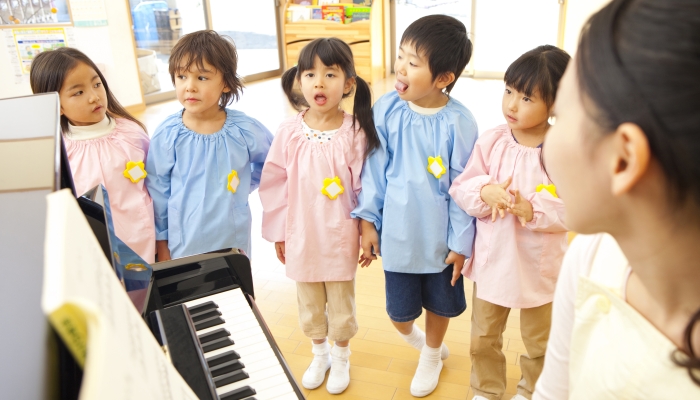
Preschool music and fun kids’ songs are perfect for entertaining the whole class. You can play music for children as they learn body control and to listen closely to directions. Preschoolers learn through example, so don’t hesitate to show off your dance moves.
It’s not always easy to find interesting action songs to keep preschoolers engaged, so here are a few of my favorites:
- Going on a Bear Hunt – Fantastic for getting kids moving around.
- Hokey Pokey – Great for teaching body part identification.
- Tissue Dance – Put a tissue on your head and dance around without letting the tissue fall.
- Feather Dancing – Have children wave feathers depending on the speed of the music.
- Musical Statues – Like freeze dance, children must stop when the music stops.
Kids love to get up and move around during the day, so don’t be afraid to add movement songs to your daily routine. If you don’t have enough space, take the classroom outside, which is also a fun change of scenery.
Musical Crafts
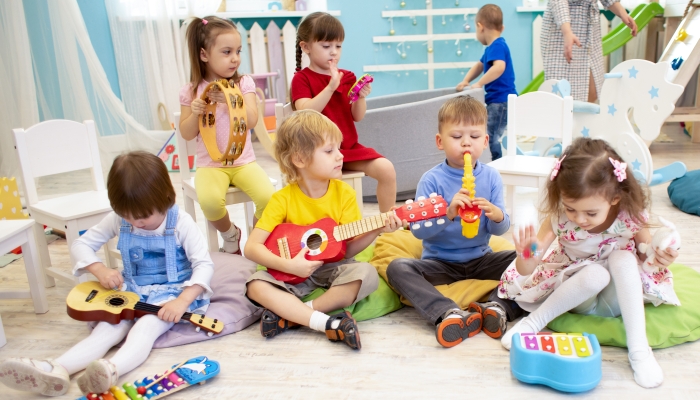
Preschoolers love crafts, and I love making DIY musical crafts. Musical instruments for kids are a fun way to bring the love of music to the classroom.
Here are a few of my favorite musical crafts to accompany your movement activities.
- DIY Shaker – Fill plastic bottles with various items like dried beans, rice, or beads to make a fun musical instrument.
- Paper Plate Tambourines – Place a handful of jingle bells between two paper plates and tape shut.
- Dancing Ribbon Rings – Attach long ribbons to wooden or plastic rings and let the children dance around to instrumental music.
Musical crafts and playing instruments encourage creativity and provide a hands-on and interactive approach to learning rhythm, sound, and music.
Rhythmic Games
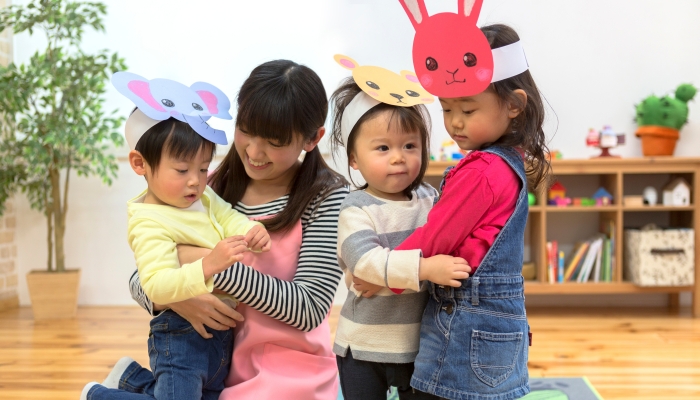
Rhythmic games are fantastic music and movement activities for working on counting skills, new vocabulary words, and different sounds. Children learn brilliantly through movement activities, so it’s always a great idea to get kids up and moving during the day.
Examples of rhythmic games include:
- Musical chairs
- Follow the leader
- Sound hunt
- Animal dance
- Name that tune
If the kids are having difficulty listening, it’s best to stop the game and start when you have everyone’s attention. Music and movement activities are fun but can get kids excited, and their listening ears may get clogged.
10 Tips for Parents and Educators
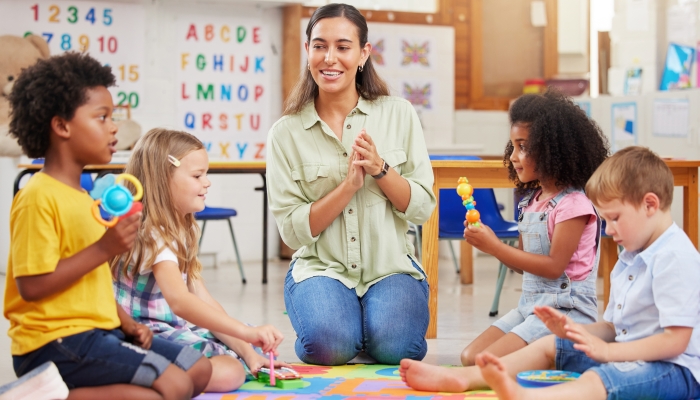
Preschool teachers and parents are a child’s first influence in life, and adding daily music and movement activities can significantly impact their learning.
While it can be overwhelming, here are a few more ideas to consider while promoting music in the classroom:
- Opt for upbeat music, classical music, and singing songs.
- Consider the child’s age and preferences when making selections.
- Determine your learning objectives when bringing music into the classroom.
- Make it interactive and engage preschoolers in the selection and performance of music.
- Monitor and adapt while observing the child’s development and responses.
- Encourage active listening and talk about the music you are listening to.
- Add music to lesson plans, enhancing learning across the curriculum.
- Demonstrate your enjoyment and enthusiasm for music.
- Utilize props and visual aids to reinforce concepts of music.
- Allow time for free exploration of musical instruments and movement activities.
The key is to make music and movement accessible and enjoyable, fostering a positive association with creativity and learning.
FAQs
What types of music are suitable for preschool-aged children?
Finding lively and rhythmic tunes, including nursery rhymes and simple melodies, is best when looking for preschool movement songs. In addition, adding learning songs that teach the colors, numbers, and the alphabet helps incorporate educational content.
How can I incorporate music into a preschooler’s daily routine?
You can add music at transitional moments during the day, such as circle time, clean-up, getting ready, and counting. You can also use music when introducing new words to make learning fun.
What are some strategies to engage reluctant participants in music and movement activities?
If you are having difficulty in engaging your kids in music activities, consider these strategies:
- Offer choices in music activities, allowing the kids to pick their instruments and style of music.
- Introduce familiar music to help create a connection.
- Create small groups to help kids gradually open up and become more comfortable.
- Foster a supportive and inclusive atmosphere where all kids feel accepted and encouraged.
- Be flexible in your approach to adding music and movement activities based on the children’s interest and comfort level.
How can I ensure safety during preschool movement songs?
It’s always important to remind children to keep body parts to themselves as they enjoy movement songs and work on physical development. In addition, ensure you remove any obstacles or hazards from the space to prevent injury.
References
- Habibi, A., Cahn, B. R., Damasio, A., & Damasio, H. (2016). Neural Correlates of Accelerated Auditory Processing in Children Engaged in Music Training. Developmental Cognitive Neuroscience, 21, 1–14. https://doi.org/10.1016/j.dcn.2016.04.003
- Nam Yoon, J. (2000). MUSIC IN THE CLASSROOM: ITS INFLUENCE ON CHILDREN’S BRAIN DEVELOPMENT, ACADEMIC PERFORMANCE, AND PRACTICAL LIFE SKILLS. EDUCATIONAL RESOURCES INFORMATION CENTER (ERIC). https://files.eric.ed.gov/fulltext/ED442707.pdf
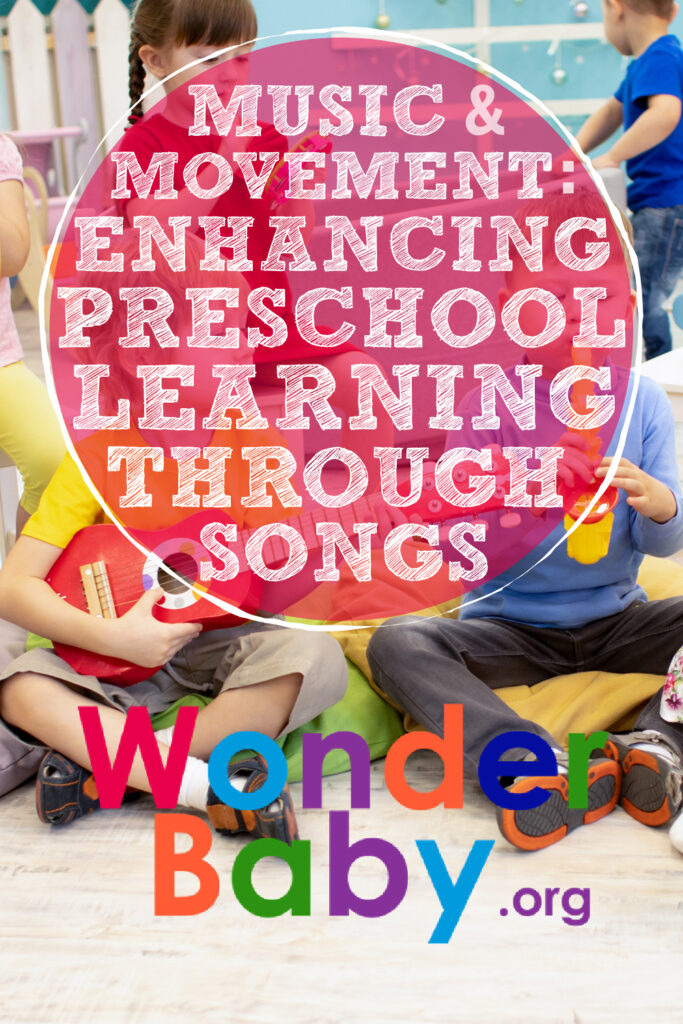
Related Posts
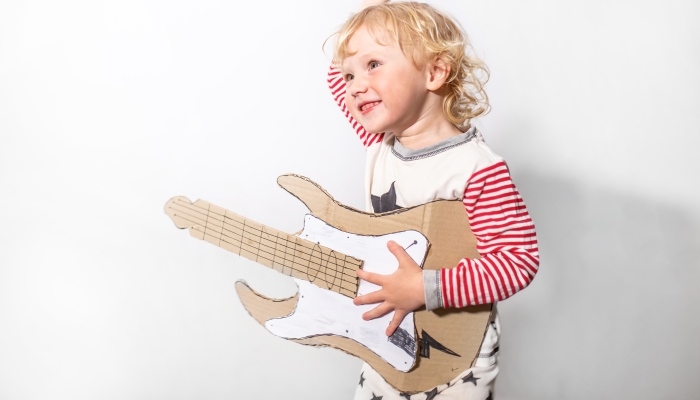
Music Play
5 Fun DIY Musical Instruments for Kids
Looking for a rainy day activity you can do on a budget? Get your little rock stars into these easy, crafty DIY musical instruments with stuff you have at home.
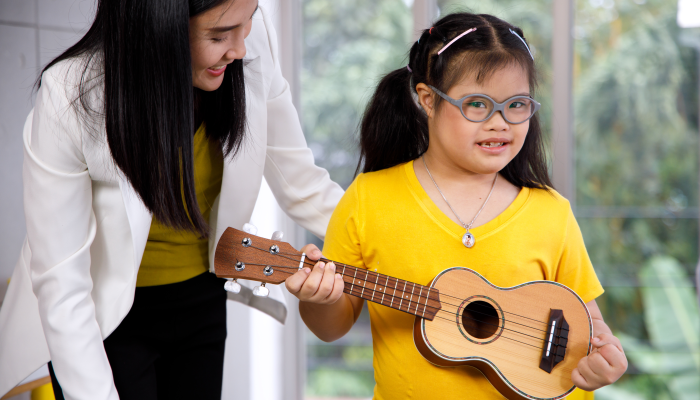
Autism, Music Play
6 Ways Music Therapy Can Support Children With Autism
By harnessing the power of music, autistic children can develop communication, social, emotional, cognitive, and motor skills. Here’s how!
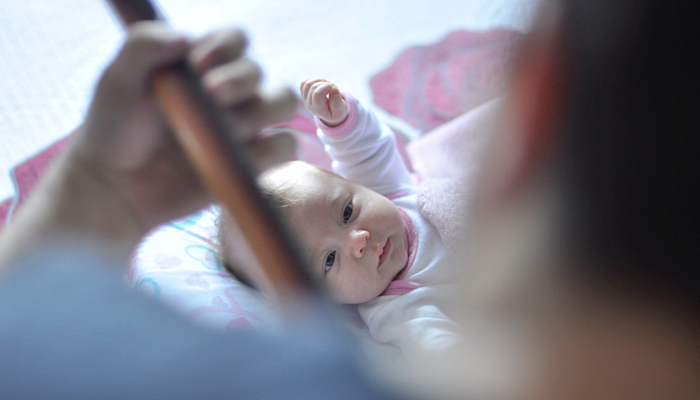
Music Play, Visual Impairment
Why We Love Music Therapy for Our Blind Son
Jennie writes about how her son, Max, responds to music. Other therapies failed Max and often stressed him out, but Music Therapy has been very successful for him!